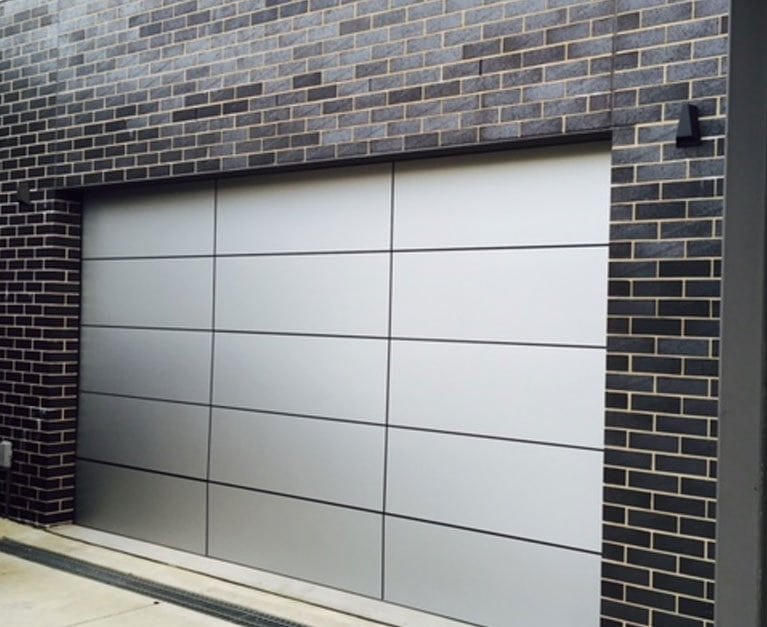I sincerely believe that it is the question that I have been asked most in my professional life: we could say that it is the “million dollar question” …
What type of garage door is best for my community of owners ?
Which door would cause less problems in my community garage ?
There is no written rule that determines which garage door is best for one community or another, so it would always be better to see it on site. However, there are some general rules that can be followed in almost all cases, which are what I am going to explain.
I will discuss four types: hinged door , sliding door , sectional garage door and overhead door counterweight . I do not want to analyze the dock and roll up doors, since they are practically obsolete for garages of owners’ communities , and are used only in exceptional cases.

SWING GARAGE DOOR
- (Also called pivot door or swing door):
- Friction and friction points:
- The swinging garage door has only two friction points (the two hinges)
- Cables:
- The swing garage door has no wires
- Unions:
- On the swinging door the hinges are welded to the frames and to the frame, giving it an extraordinary strength and avoiding slopes and future problems, even in doors with intensive use
- Compensation systems:
- They have no counterweights
- Automatism:
- In the pivot garage doors the automatism is a linear hydraulic or electromagnetically operator -as long as they are for intensive use- which, due to its design and its characteristics, can be used without problems in an installation that requires many maneuvers a day .
- Advantages:
- Probably the most common model due to its simplicity of operation and use
- If a suitable motor is used, it is very quiet
- Simple and intuitive opening in case of breakdown or lack of power
- It is a simple door that all users know how to use
- It has the possibility of having a reversible motor (in case of breakdown or lack of current, it can be moved without having to unlock anything): this will prevent the untrained user from damaging the garage door due to misuse
- Disadvantages:
- It is not recommended in areas where there is a lot of wind , since it makes it very difficult to close it. In case it is essential to place this model in windy areas, it will be necessary to make a door whose surface is perforated sheet or bars
- It is essential to have a reversible motor : otherwise, if the garage door breaks down, an untrained user will force the door and cause damage to the door or the motor
- If the hinges are not of quality, the door may suffer pick-ups and friction on the floor
- When opening to the side, if we have parking spaces on the sides, it will interrupt the passage to them
- If the engine is not well regulated, it may close or open with too much force, thus causing garage door slamming and inconvenience to neighbors
- If it does not open fully and the output is tight, it may hit a car
- Friction and friction points:

SLIDING GARAGE DOOR
- Also called sectional door, panel door, or articulated door
- Friction and friction points:
- The sectional door is a door that, due to its construction, has many friction and friction points (in a standard garage door, about 3500x2200mm, it has about 30 friction points: hinges, bearings, fittings, etc.)
- Cables:
- The sectional garage door has some standard cables that, due to intensive use, wear away until they eventually break apart.
- Unions:
- In the sectional door the joints between panels are made through self-tapping screws : the hinges are joined to the panels by means of screws that are threaded to the sheet. In the long run, due to intensive use, the screws loosen and the hinges and fittings end up loosening from the garage door.
- Compensation systems:
- In the sectional door the weight of the door is compensated by a torsion spring . This wharf, of course, has a limited life, which will be much shorter in doors of intensive use, resulting in the breakage of the same and the problems it can cause.
- Automatism:
- In sectional garage doors, automation is a ceiling-to-chain motor that is not designed for intensive use.
- Advantages:
- Very quiet
- It does not occupy space on the sides
- Disadvantages:
- You need to be indoors ( it can’t rain )
- If the unlocking procedure is unknown, it can be broken by trying to open it manually
- It is not designed for intensive operation (communities with more than 25 parking spaces), as cables and springs have a short life
- With the passage of time it progressively deteriorates, and each time it will have more expensive and frequent breakdowns
- Friction and friction points:
- SWING DOOR OF COUNTERWEIGHTS (Also called pleleva door, artileva door, weight door or book door):
- Friction and friction points:
- The counterweight swing door has about seven friction points on a garage door of standard dimensions , and is manufactured with special hinges for intensive use
- Cables:
- It has thick special cables for intensive use (self-lubricated)
- Unions:
- In the swinging counterweight garage door, as in the pivoting door, the hinges are welded to the frames and to the frame, leaving a very robust and strong garage door, prepared for high maneuverability.
- Compensation systems:
- In the swinging counterweight doors the weight of the garage door is compensated by means of weights housed in the side drawers, with pulleys with double support (with adjustment and mooring with tortillería and with anchor plate to work). There is no problem in its intensive use .
- Automatism:
- The automatism is formed by an operator of lateral traction of direct current , with transmission to chain that can be used without problems in installations that require a motor of intensive use.
- Advantages
- If it is a garage door with CE marking , it is highly secure
- It is ideal in garages with high frequency of passage ( intensive use )
- Disadvantages:
- Difficult to unlock if there is a breakdown or a power outage
- You need to be indoors (it can’t rain)
- You need a minimum space of about twenty centimeters on each side, to accommodate the counterweight drawers of the garage door
- Friction and friction points:
These are the essential characteristics of the main types of garage doors that are usually put in community garages. There are many more, but these that I have reviewed are the main ones when deciding on one model or another.






